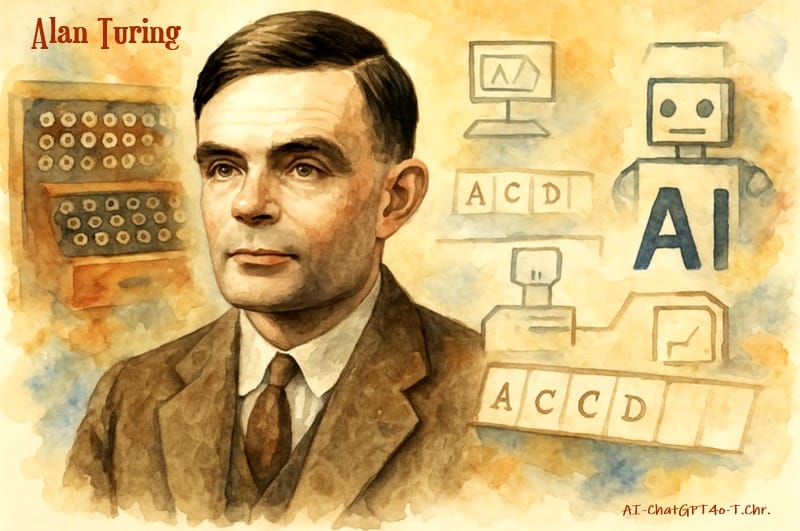ALAN TURING (1912-1954)

By AI-ChatGPT4o-T.Chr.-Human Synthesis-21 May 2025
Alan Turing was a British mathematician, logician, cryptanalyst, and pioneer in computer science and artificial intelligence. He is best known for:
The Turing Machine (1936) – A theoretical model that laid the groundwork for modern computers, helping define the limits of what machines can compute.
Codebreaking at Bletchley Park – During World War II, Turing played a central role in deciphering the German Enigma code, significantly shortening the war and saving millions of lives.
The Turing Test (1950) – A test he proposed to determine a machine’s ability to exhibit intelligent behavior indistinguishable from a human's. It remains a foundational idea in AI.
Turing is now regarded as one of the most influential figures of the 20th century.
Alan Turing's work on Artificial Intelligence (AI) was foundational, even though the field did not formally exist during his lifetime. His most influential contributions to AI include:
- The Turing Test (1950)
In his landmark paper, “Computing Machinery and Intelligence”, Turing posed the famous question:
"Can machines think?"
Instead of trying to define "thinking," he proposed the Imitation Game, now known as the Turing Test:
A human interacts (via text) with both a machine and another human.
If the interrogator cannot reliably tell which is the machine, the machine is said to exhibit intelligent behavior.
This test remains a philosophical and practical benchmark in AI.
- Early Vision of Machine Learning
Turing speculated that machines could learn, and even "train themselves"—a vision of what we now call machine learning. He suggested:
Machines could be programmed like children and learn through experience.
Neural-like mechanisms could enable adaptation and intelligence.
- The Universal Machine Concept
Turing’s idea of the universal Turing machine (1936) predicted that one machine could simulate the behavior of any other machine. This is the theoretical backbone of all modern computers, including those used in AI today. - Turing’s "Unorganized Machines"
In his later work, Turing proposed designs for artificial neural networks—he called them "A-type" and "B-type unorganized machines." This work predated formal neural network research by decades.
Legacy in AI
Turing is now considered a founding father of AI. Though he didn’t build intelligent machines himself, his theoretical frameworks continue to shape modern AI research—from natural language processing to reinforcement learning.
Turing’s Vision of Learning Machines
In his 1950 paper "Computing Machinery and Intelligence," Turing proposed that instead of trying to create a fully intelligent adult mind in a machine from the start, it would be more practical to:
“Build a child machine and then teach it.”
This was revolutionary. He was suggesting that intelligence could emerge from learning and experience, not just be hard-coded—a concept central to machine learning today.
Key Ideas in His Vision
Education over Programming
Turing believed the machine should be trained rather than directly programmed for every task. Just as a child learns from rewards, punishments, and repetition, a machine could be guided toward intelligent behavior.
Trial and Error Learning
He imagined that machines could use trial-and-error processes to improve their performance over time—an early notion of reinforcement learning.
“Unorganized Machines”
Turing sketched out designs for machines made up of simple neuron-like units, which could be connected and trained. These ideas anticipated artificial neural networks, though his models were not mathematically developed in detail.
Mutation and Evolution
Turing also toyed with the idea of evolutionary computation, where machines would "mutate" and be selected based on performance—similar to today’s genetic algorithms.
Why It Mattered
At a time when computers were just calculators, Turing imagined them learning, adapting, and growing—concepts that wouldn’t become mainstream until the rise of machine learning in the late 20th and early 21st centuries.
